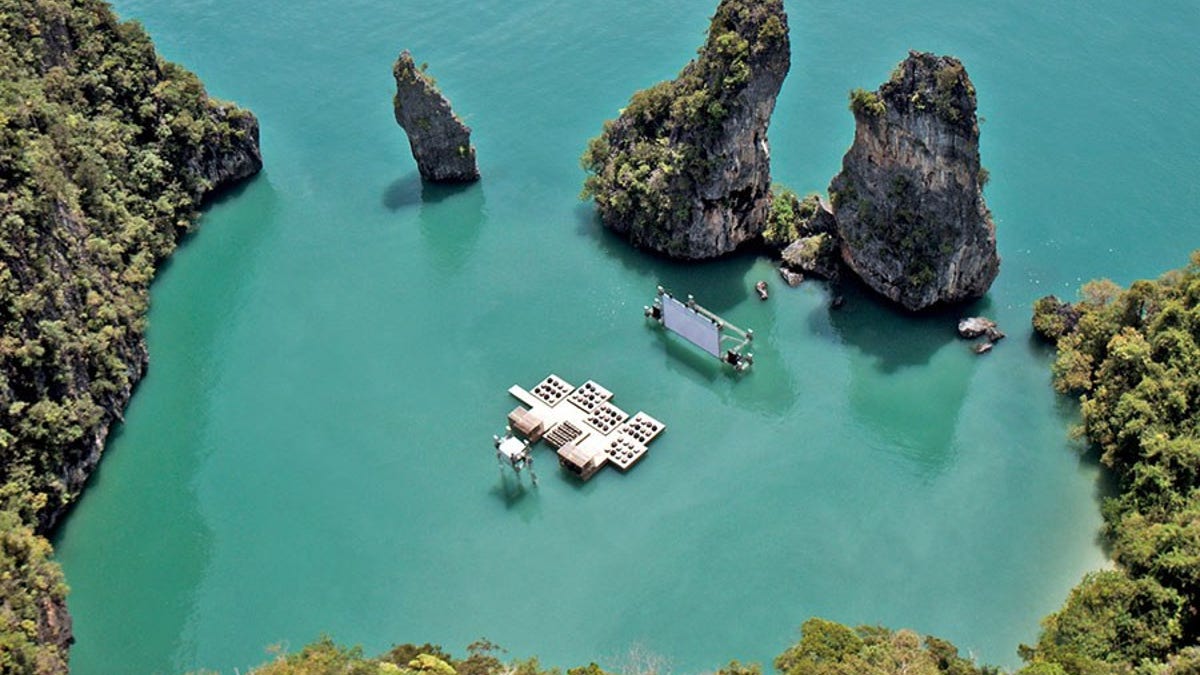
Photo: Piyatat Hemmatat, courtesy of Büro Ole Scheeren (Photo: Piyatat Hemmatat, courtesy of Büro Ole Scheeren)
For some architects, building on land just isn’t enough of a challenge anymore, so they’ve taken their design skills to the water. These astonishing floating structures can be found everywhere from Thailand to Nigeria and contain movie theaters, schools, housing, and offices.
Many of the designs include sustainable elements including solar panels and locally-sourced or biodegradable materials. But beyond their environmental benefits, these examples of floating architecture offer a unique way to experience their settings, whether it’s a canal in Amsterdam or a river in South Korea. Browse these beautiful and innovative structures from around the world. After all, with sea levels rising, these designs just might be the wave of the future.
Devised by 2014 Architectural Digest Innovator Ole Scheeren, the Archipelago Cinema is an outdoor movie theater surrounded by the towering rocks, lush vegetation, and crystal-clear water of Thailand’s Kudu Island. The architect designed the structure in collaboration with the annual Film on the Rocks Yao Noi Festival, which is curated by Thai filmmaker Apichatpong Weerasethakul and British actress Tilda Swinton. Scheeren modeled the structure after the area’s floating lobster farms, using a series of modular platforms to form the main seating section.
This residential community was commissioned by a group of water-loving families in the Netherlands. Drijf in Lelystad, which translates to “Float in Lelystad,” was designed by the Amsterdam-based firm Attika Architekten. Construction took place roughly 25 miles outside of the city, and the completed structures, built on concrete caissons, were towed over water to their destination. In total, eight timber-frame homes—all custom made to fit the requirements of each family—were erected for the project.
More From Architectural Digest
More: Take an Exclusive Look at Mexico's Overwater Bungalows
Located in Seoul, South Korea, Floating Island was conceived as part of the Han River Renaissance—a municipal campaign to revitalize an often overlooked area of the city. A collaboration between H Architecture in New York and Haeahn Architecture in Seoul, the complex consists of three structures, representing the three stages of a blooming flower: seed, bud, and blossom. Formed from glass, wood, and steel, the islandlike buildings house shops, restaurants, and a number of venue spaces that host festivals, performances, and exhibitions throughout the year.
Makoko Floating School in Lagos, Nigeria, was conceived by the architecture studio NLÉ as a prototype for buildings that could be moved around coastal regions prone to flooding. Fashioned on a floating base, the three-story school, made from locally sourced bamboo and wood, includes an assembly area, four classrooms, and a workshop. What’s more, the A-frame structure has the capacity to support hundreds of residents in case of emergency.
London’s Camley Street Natural Park was built on top of a deserted coal yard along Regent’s Canal in 1984. Today, the park is a sanctuary for the city’s wildlife and home to Viewpoint Pavilion, a floating platform where visitors can observe nature directly from the canal. Devised by Finnish firm AOR in 2014, the structure was inspired by traditional Scandinavian laavus, primitive shelters that blend into their natural surroundings. The London Wildlife Trust often hosts educational programs at the pavilion.
When designing an office for a company responsible for cleaning and maintaining Amsterdam’s waterways, Attika Architekten knew sustainability was paramount. Located in the northern part of the old city harbor, the floating office of Waternet has a timber frame and a thatched-reed façade, both of which are fully reusable and biodegradable if disassembled. Work spaces and a cafeteria are found on the upper levels, while a concrete caisson that sits below the water contains employee locker rooms. At a sprawling 9,418 square feet, the office is the largest floating building in the Netherlands.
Slatted-timber siding covers the exterior of Framework Architecten and Studio Prototype’s Water Villa, a house that rests in a canal southwest of Amsterdam’s city center, close to the stadium built for the 1928 Summer Olympics. The three-level residence encompasses 2,690 square feet, and the interior features sleek hallways, an all-white kitchen, and a spacious living area. Sunlight streams into the home through the exterior slats and a skylight above the atrium. The design allows the homeowners to enjoy all the natural elements that surround Water Villa.



















